By Maxine Carter-Lome, publisher
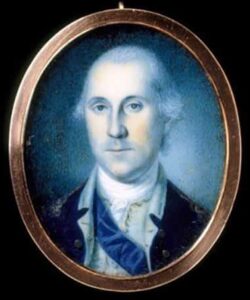
In his day, and even today thanks to portraits painted while he was alive along with copies from those images made after his death, George Washington was and continues to be one of the most recognized figures in American history. Whether presented as a Revolutionary War hero or as President of the United States, his images, as captured by the greatest portraitists of his day, exemplify leadership and our ideals as a nation.
At first, George Washington was a reluctant portrait-sitter, writing, “I am so hackneyed to the touches of the Painters pencil, that I am now altogether at their beck, and sit like patience on a Monument, whilst they are delineating the lines of my face.” However, over time his growing patience toward the capturing of his likeness produced some of the most celebrated works of art in America.
After his presidency and well past his death, copies of the portraits he sat for during his lifetime were hung in American homes and government buildings throughout the country as a symbolic form of patriotism in the New Republic. Washington’s likeness also adorned commemorative coins, collectible plates, textiles, bronze sculptures, almanacs, and prints, copies of which were meant to be framed.
The National Portrait Gallery alone owns more than one hundred portraits of George Washington in a variety of mediums, including prints, sculptures, and paintings. Although many date from the American Revolution, even more were created during and after his presidency.
Portraits of Washington created during his lifetime represent a diverse and talented group of international artists. Here are a few of the most noted, iconic images of Washington used as the foundation for future artists, sculptures, and illustrators looking to capture the planter, General, and President in all his glory for posterity.
Charles Willson Peale (1741-1827)
Charles Willson Peale was an American painter, soldier, scientist, inventor, politician, and naturalist, best remembered for his monumental portraits of George Washington and other Revolutionary War-era figures.
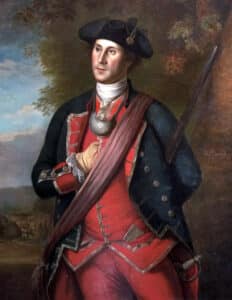
Between 1772 and 1795, Washington sat for Peale seven times. George Washington as Colonel in the Virginia Regiment by Peale was commissioned by Martha Washington in 1772 as a companion to the 1757 portrait of her by John Wollaston, completed during her first marriage. It depicts George Washington in his role as Colonel of the Virginia Regiment during the French and Indian War and is considered the earliest known portrait of Washington. Both paintings hung in the Front Parlor at Mount Vernon from 1772-1802, among other family portraits. After the Washingtons’ deaths, the portrait was inherited by their grandson, George Washington Parke Custis of Arlington House. Today, it is part of the Washington-Custis-Lee Collection, given by Lee descendants to Washington & Lee University.
A later portrait of Washington by Peale, George Washington, was commissioned by John Hancock during the Revolutionary War to celebrate driving the British out of Boston in March 1776.
Peale traveled to the location of the Continental Army in northern New Jersey near present-day New Market to meet with Washington for this portrait; however, Peale found him preoccupied by the war. Peale recorded that Washington had “promised to sit for his miniature, but at this Time he had not had the leisure.” Eventually, Washington sat for the artist on September 28 in Pennsylvania. That same year, Peale also painted a miniature of Washington at the request of Mrs. Washington.
Peale’s Washington at Princeton, c. 1779-81, was commissioned for the State House in Pennsylvania to commemorate the victories of Trenton and Princeton. In it, Washington is wearing the blue uniform with buff facings of the general staff. The blue sash indicates his position as Commander-in-Chief. It is believed that Washington was so pleased with Washington at Princeton that he commissioned Peale to paint a miniature of this image in the same uniform as a present for his younger sister Betty Washington Lewis. Today, Washington at Princeton resides at The Pennsylvania Academy of Fine Arts in Philadelphia, PA.The success of Washington at Princeton led to orders for replicas of the painting. In August 1779, Peale wrote: “I have on hand a number of portraits of Gen. Washington. One the ambassador had for the Court of France, another is done for the Spanish Court, one other has been sent to the island of Cuba, and sundry others, which I have on hand are for private gentlemen.” One of the most notable variations of the Princeton portrait is Washington at Trenton, which shows the general in an updated military dress wearing his state sword (probably painted between June and August of 1780). It is believed that this portrait was commissioned by Martha Washington and completed after Washington’s death.
Gilbert Stuart (1755-1828)
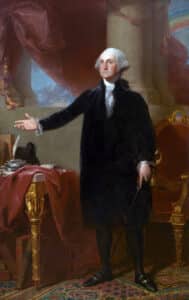
An American painter born in the Rhode Island Colony in 1755, Gilbert Stuart is widely considered one of America’s foremost portraitists. Of the well-over 1100 pictures he created over his five-decade career, nearly one-tenth are images of George Washington, to whom he was introduced by their mutual friend Chief Justice John Jay.
Stuart executed three different portraits from life sittings with the president and painted at least 100 portraits of George Washington to sell to eager patrons. Stuart reportedly told a friend, “I expect to make a fortune by Washington alone.”
Stuart’s portrayal of Washington became so pervasive that, as the artist’s biographer, the critic William Dunlap, put it in 1832, “if George Washington should appear on earth, … he would be treated as an impostor, when compared to Stuart’s likeness of him, unless he produced his credentials.”
Washington’s sittings for Stuart in Philadelphia, between 1795 and 1796, resulted in three distinctive images known as the “Vaughan” portrait, the “Athenaeum” head, and the “Lansdowne” portrait. With the demand for images high, Stuart painted many copies of these works.
The “Vaughan” portrait, named for Samuel Vaughan, an American merchant living in London, who was the recipient of the original painting, was painted in 1795.
The “Athenaeum” head, begun in 1796, was Stuart’s second and most important life portrait of Washington. Although unfinished, it is considered the most famous painting of the first president. Stuart retained the original and used it to paint scores of copies that were commissioned by patrons in America and abroad. The image of George Washington featured in the painting has appeared on the United States’ one-dollar bill for more than a century, and on various postage stamps of the 19th century and early 20th century.
Named for the Marquise of Lansdowne, former British Prime Minister and recipient of the work, the “Lansdowne” painting is a full-body portrait of Washington, depicting the 64-year-old president of the United States during his final year in office. Stuart painted only Washington’s head from life (the first president dreaded sitting for painters—especially Stuart), substituting a stand-in to complete the figure. The original of this portrait can be found in the National Portrait Gallery in Washington, D.C.
Joseph Wright (1734-1787)

New Jersey, in the fall of 1783, just before he traveled south to resign his command.
Joseph Wright, an American portrait painter and sculptor, is known for his life portraits of George Washington and Benjamin Franklin and as a designer of early U.S. coinage. Wright was President Washington’s original choice for Chief Engraver of the U.S. Mint but died at age 37 before being confirmed to that position.
Joseph Wright made multiple images of George Washington in several formats and media, including paintings, sculptures, and one engraving.
After the Treaty of Paris was signed on September 3, 1783, officially ending the war, Wright was one of two or three artists invited to the General’s headquarters at Rocky Hill, New Jersey, to commemorate the event. Wright was granted a single sitting and painted a 1/2-length study—oil on mahogany panel, 14 1/8 x 12”, now in the collection of the Philadelphia History Museum. There are five known painted portraits that all derive from this sitting.
Wright’s plaster profile of Washington was hung in the Mansion study where it is exhibited today. Of the experience, Washington recorded in his diary, “Wright came … with the singular request that I should permit him to take a model of my face, in plaster of Paris, to which I consented, with some reluctance. He oiled my features over; and placing me flat upon my back, upon a cot, preceded to daub my face with the plaster. Whilst in this ludicrous attitude, Mrs. Washington entered the room; and seeing, my face thus overspread with the plaster, involuntarily exclaimed. Her cry excited me in a disposition to smile, which gave my mouth a slight twist, or compression of the lips that is now observable in the bust which Wright afterward made.”
William Dunlap (1766-1839)
William Dunlap was just 17 in 1783 when he sketched the General from life. He was staying at the home of Mr. and Mrs. John Van Horne near Washington’s temporary headquarters in Rocky Hill, New Jersey where Washington was a frequent guest. It is said that Washington may have admired the sketches Dunlap did of the Van Hornes, who suggested to Washington that he and Mrs. Washington might like to sit for the young artist, as well, while he was with them.
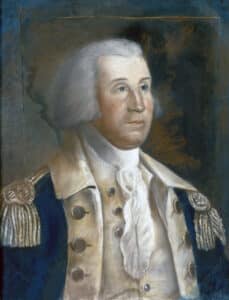
pastel on paper by William Dunlap
Dunlap’s sketch of Washington dressed in his Continental army uniform, done in pastel on paper, is remarkable as it is his earliest-known painting. The painting survived (despite damage by fire while it resided in San Francisco) for more than 150 years in the possession of the Van Horne family, its authenticity affirmed by Dunlap himself. The portrait of Mrs. Washington, however, did not survive. Dunlap claimed of his Washington portraits, “I made what were thought likenesses.” Today, Washington’s portrait sits in the United States Senate, a Gift of Anne Middleton Ellis in Memory of Her Husband, Augustus Van Horne Ellis.
John Trumbull (1756-1743)
Both a soldier and an artist, John Trumbull was a former aide to General George Washington during the American Revolution and is known for his many portraits of Revolutionary War heroes.
Trumbull painted three known lifetime bust-length portraits of George Washington. George Washington and William Lee (George Washington) was painted in 1780 and depicts Washington standing on a bluff above the Hudson River with a Black figure assumed to be William Lee – his enslaved valet, groom, and military aide. Having served on Washington’s staff as an aide-de-camp early in the Revolutionary War, Trumbull was able to paint this work from memory years later, while studying in London. It was the first authoritative portrayal of Washington available in Europe and was soon widely copied.

George Washington, ca. 1790
photo: The Cleveland Museum of Art
Trumbull’s image of Washington at Verplanck’s Point, New York, 1782, Reviewing the French Troops after the Victory at Yorktown, was painted in 1790 and today can be found in the Winterthur Museum, Winterthur, Delaware. Washington recorded in his diary on July 8, 1790, “Sat from 9 o’clock till after 10 for Mr. Jno. Trumbull, who was drawing a Portrait of me at full length which he intended to present to Mrs. Washington.”
The third, a portrait of Washington painted by Trumbull circa 1793, sold at Christie’s in 2013 for $1.3 million. The other two are in the collections of the Yale University Art Gallery and Harvard University Art Museums, respectively.
Celebrating America’s Semiquincentennial

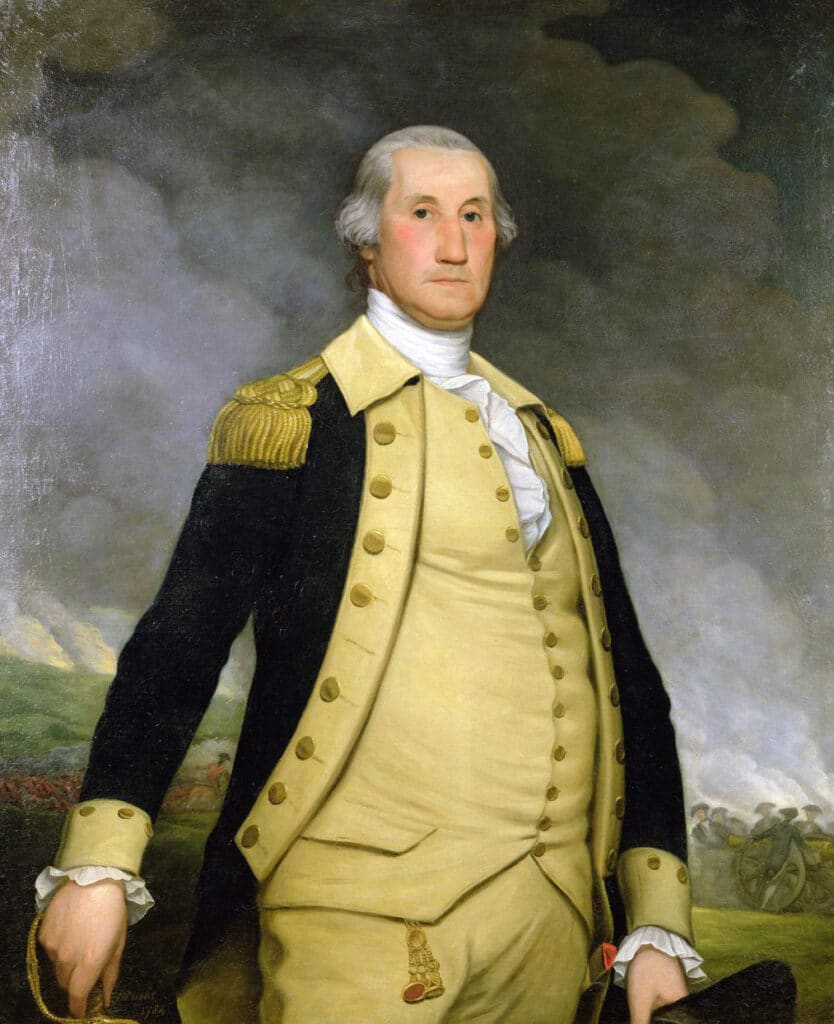



Related posts: